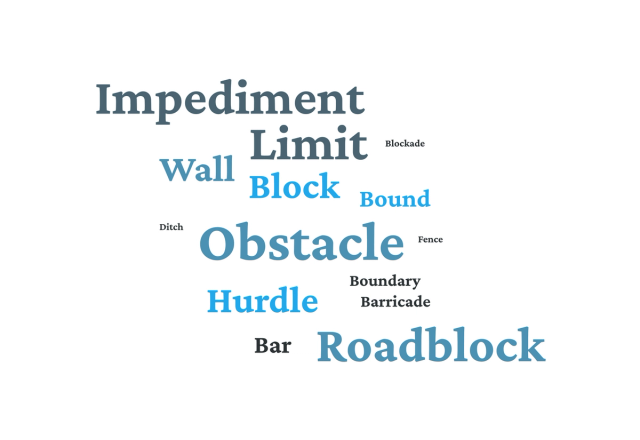Accessibility
The UDL framework takes learner variability as a given and encourages educators to design learning environments that anticipate variability. Anticipating variability means adjusting the learning environment to remove barriers and create access.
This word cloud presents some terms that previous participants have connected with and expressed when they reflected on the word “barrier” as it relates to learning.

All colleges and universities in Ontario have attempted to remove barriers through accessibility policies that meet the Ontario government’s mandate under the Accessibility for Ontarians with Disabilities Act and The Ontario Human Rights Commission Policy on Accessible Education for Students with Disabilities. Despite this, lack of accessibility remains an issue in Ontario’s academy. UDL can serve as a proactive guide for embedding accessibility in curriculum development. And it is predicated on the premise that what is useful for one can support many more as well. This is in keeping with the social model of disability.
The social model of disability views disability as a consequence of environmental, social, and attitudinal barriers that prevent people with a disability from active participation in all areas of society. The model shifts the problem of lack of access and inclusion from the person with disabilities to society. For example, in a learning environment, the cause of lack of access is that the curriculum and the institution have been designed by and for nondisabled people. (This will be explored further in Module 2.)
This video explains how a UDL approach supports student retention:
UDL and Retention
[music]
SAM JOHNSTON: So we know from retention research that, we actually, when we think about retention and study retention, we often forget to study the classroom. But the classroom is really, really critical. I mean it's the key element in why students persist or why they don't. And UDL really offers a systematic way of looking at the persistence of all students in the classroom. That's why UDL is so critical for this issue of student persistence and institutions trying to retain their students. It offers a systematic framework to look at better supporting all students in the classroom so they can persist in a course, get a degree, and get to the next place they want to go.
UDL and Retention - Runtime 0:57 min
https://youtu.be/T1yIe8ZMwc0
The UDL approach sees accessibility as important not just for learners who have a disability but for all learners. From a social model perspective, “it is UDL strategies, not accommodations, that effectively target disability barriers—barriers that exist in the learning environment, not in the individual learner” (Hills, 2022). The Inclusive Education Pyramid created by the Association for Higher Education Access and Disability (AHEAD), in collaboration with the Disability Advisors Working Network (DAWN), reminds us that all learners require differing levels of support.
Inclusive Education Pyramid

At level 1, the incorporation of UDL principles into mainstream teaching, learning, and assessment practices will support the majority of students. Of course, students with disabilities should still be afforded the opportunity to complete accessibility assessments, even if their needs can be met at this level.
At level 2, supports for groups of students with similar needs may include specific tutoring supports or alternative venues for students with similar exam needs.
Level 3 notes that individual accommodations remain a very important part of an inclusive institution. This may include assistive technology and individual flexibility with deadlines to enable full participation in the learning experience.
And level 4 acknowledges that some students might need more personal, professional supports; for example, students with certain disabilities may require the use of a personal assistant on campus, or in an exam setting, a reader or scribe (AHEAD, 2017).